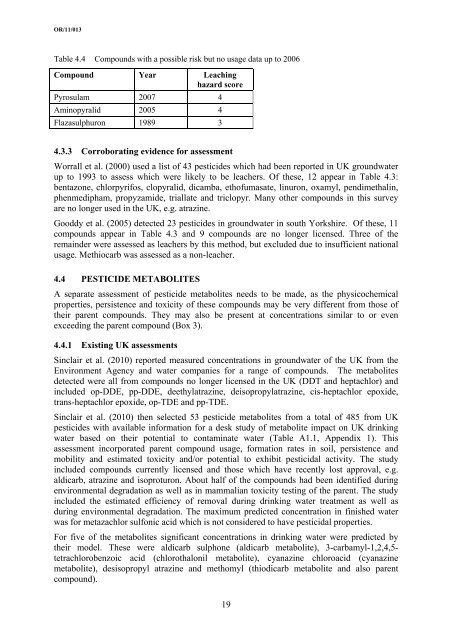Emerging contaminants in groundwater - NERC Open Research ...
Emerging contaminants in groundwater - NERC Open Research ...
Emerging contaminants in groundwater - NERC Open Research ...
You also want an ePaper? Increase the reach of your titles
YUMPU automatically turns print PDFs into web optimized ePapers that Google loves.
OR/11/013<br />
Table 4.4 Compounds with a possible risk but no usage data up to 2006<br />
Compound Year Leach<strong>in</strong>g<br />
hazard score<br />
Pyrosulam 2007 4<br />
Am<strong>in</strong>opyralid 2005 4<br />
Flazasulphuron 1989 3<br />
4.3.3 Corroborat<strong>in</strong>g evidence for assessment<br />
Worrall et al. (2000) used a list of 43 pesticides which had been reported <strong>in</strong> UK <strong>groundwater</strong><br />
up to 1993 to assess which were likely to be leachers. Of these, 12 appear <strong>in</strong> Table 4.3:<br />
bentazone, chlorpyrifos, clopyralid, dicamba, ethofumasate, l<strong>in</strong>uron, oxamyl, pendimethal<strong>in</strong>,<br />
phenmedipham, propyzamide, triallate and triclopyr. Many other compounds <strong>in</strong> this survey<br />
are no longer used <strong>in</strong> the UK, e.g. atraz<strong>in</strong>e.<br />
Gooddy et al. (2005) detected 23 pesticides <strong>in</strong> <strong>groundwater</strong> <strong>in</strong> south Yorkshire. Of these, 11<br />
compounds appear <strong>in</strong> Table 4.3 and 9 compounds are no longer licensed. Three of the<br />
rema<strong>in</strong>der were assessed as leachers by this method, but excluded due to <strong>in</strong>sufficient national<br />
usage. Methiocarb was assessed as a non-leacher.<br />
4.4 PESTICIDE METABOLITES<br />
A separate assessment of pesticide metabolites needs to be made, as the physicochemical<br />
properties, persistence and toxicity of these compounds may be very different from those of<br />
their parent compounds. They may also be present at concentrations similar to or even<br />
exceed<strong>in</strong>g the parent compound (Box 3).<br />
4.4.1 Exist<strong>in</strong>g UK assessments<br />
S<strong>in</strong>clair et al. (2010) reported measured concentrations <strong>in</strong> <strong>groundwater</strong> of the UK from the<br />
Environment Agency and water companies for a range of compounds. The metabolites<br />
detected were all from compounds no longer licensed <strong>in</strong> the UK (DDT and heptachlor) and<br />
<strong>in</strong>cluded op-DDE, pp-DDE, deethylatraz<strong>in</strong>e, deisopropylatraz<strong>in</strong>e, cis-heptachlor epoxide,<br />
trans-heptachlor epoxide, op-TDE and pp-TDE.<br />
S<strong>in</strong>clair et al. (2010) then selected 53 pesticide metabolites from a total of 485 from UK<br />
pesticides with available <strong>in</strong>formation for a desk study of metabolite impact on UK dr<strong>in</strong>k<strong>in</strong>g<br />
water based on their potential to contam<strong>in</strong>ate water (Table A1.1, Appendix 1). This<br />
assessment <strong>in</strong>corporated parent compound usage, formation rates <strong>in</strong> soil, persistence and<br />
mobility and estimated toxicity and/or potential to exhibit pesticidal activity. The study<br />
<strong>in</strong>cluded compounds currently licensed and those which have recently lost approval, e.g.<br />
aldicarb, atraz<strong>in</strong>e and isoproturon. About half of the compounds had been identified dur<strong>in</strong>g<br />
environmental degradation as well as <strong>in</strong> mammalian toxicity test<strong>in</strong>g of the parent. The study<br />
<strong>in</strong>cluded the estimated efficiency of removal dur<strong>in</strong>g dr<strong>in</strong>k<strong>in</strong>g water treatment as well as<br />
dur<strong>in</strong>g environmental degradation. The maximum predicted concentration <strong>in</strong> f<strong>in</strong>ished water<br />
was for metazachlor sulfonic acid which is not considered to have pesticidal properties.<br />
For five of the metabolites significant concentrations <strong>in</strong> dr<strong>in</strong>k<strong>in</strong>g water were predicted by<br />
their model. These were aldicarb sulphone (aldicarb metabolite), 3-carbamyl-1,2,4,5tetrachlorobenzoic<br />
acid (chlorothalonil metabolite), cyanaz<strong>in</strong>e chloroacid (cyanaz<strong>in</strong>e<br />
metabolite), desisopropyl atraz<strong>in</strong>e and methomyl (thiodicarb metabolite and also parent<br />
compound).<br />
19

















